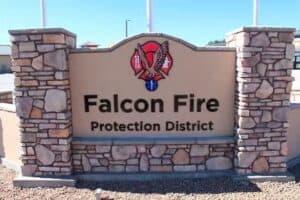Falcon Fire Protection District training chief Glenn Levy, who worked at the High Park fire in Larimer County, said residents and property owners are crucial to a fire departmentís ability to protect structures threatened by wildfire.ìPeople need to help us,î he said.ìWe have some unbelievable firefighters, some great folks, but you have to give us a chance to use what we know and the skills that we have.îThe FFPD covers 117 square miles of grassland and forest. It is a growing district, currently protecting 10,000 single-family homes or residential structures. In addition, there are thousands of non-residential buildings to protect. Because of the districtís diverse topography, typically low humidity and frequent wind; Falconís firefighters face a challenge when the alarm sounds for a wildland fire. Levy advocates a partnership between citizens and firefighters to maximize resources. ìWe have to work together to create an environment where we are in charge of the fire and the fire is not in charge of us.îResidents can help firefighters protect homes and property by creating defensible space around structures, maintaining driveways, preventing fires and reporting fires at once.Creating defensible spaceDefensible space around a structure is intended to slow a wildfireís spread toward that building, prevent a structure fire from igniting nearby forest or grassland and provide protection for firefighters defending the building during a wildland fire. A home with good defensible space is more likely to survive a wildfire than one that has trees and brush right up against it.ìYou need to create an environment around your home that virtually nothing can touch,î Levy said. ìGet fuel away from the house to give us a fighting chance.îThe FFPD recommends a minimum defensible space of 30 feet from the structure, more if the building is on a hill or slope. The first 15 feet from the building should be clear of all flammable vegetation, including pine trees and scrub oak. ìPine trees and scrub oak are really almost like flammable liquids when they get hot,î Levy said. ìOnce they go things burn a lot faster and hotter than youíd ever think they would.îTips for creating defensible space around homes and outbuildings include:
- Remove dead vegetation such as leaves, pine needles and slash piles.
- Mow dry grass and weeds to a height of 6 inches or less within 30 feet of all structures.
- Store firewood, hay and other combustible materials away from homes and outbuildings.
- Remove tree branches that overhang structures.
- Clear roofs and gutters of dead leaves and pine needles.
- Replace combustible landscaping materials like mulch with rock.
- Heed burn bans. For current information on burning restrictions in El Paso County, go to the El Paso County Sheriffís Web site at http://shr.elpasoco.com/. Click on the button labeled ìInformation on Fire Restrictions.î
- Do not throw lit cigarettes, cigarette butts or other smoking materials from vehicles.
- Make sure that power tools and machinery are properly maintained and operating correctly before using them outside. Sparks or overheating can start a wildfire, especially on hot, windy days.
- Donít park vehicles in tall grasses. The heat from catalytic converters and exhaust systems can ignite dry grass and weeds.




